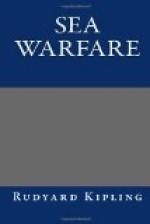Then his battle-fleet came in sight, and Beatty’s fleet went about and steered north-west in order to retire on our battle-fleet, which was hurrying down from the north. We returned fighting very much over the same waters as we had used in our slant south. The enemy up till now had lain to the eastward of us, whereby he had the advantage in that thick weather of seeing our hulls clear against the afternoon light, while he himself worked in the mists. We then steered a little to the north-west bearing him off towards the east till at six o’clock Beatty had headed the enemy’s leading ships and our main battle-fleet came in sight from the north. The enemy broke back in a loop, first eastward, then south, then south-west as our fleet edged him off from the land, and our main battle-fleet, coming up behind them, followed in their wake. Thus for a while we had the enemy to westward of us, where he made a better mark; but the day was closing and the weather thickened, and the enemy wanted to get away. At a quarter past eight the enemy, still heading south-west, was covered by his destroyers in a great screen of grey smoke, and he got away.
NIGHT AND MORNING
As darkness fell, our fleets lay between the enemy and his home ports. During the night our heavy ships, keeping well clear of possible mine-fields, swept down south to south and west of the Horns Reef, so that they might pick him up in the morning. When morning came our main fleet could find no trace of the enemy to the southward, but our destroyer-flotillas further north had been very busy with enemy ships, apparently running for the Horns Reef Channel. It looks, then, as if when we lost sight of the enemy in the smoke screen and the darkness he had changed course and broken for home astern our main fleets. And whether that was a sound manoeuvre or otherwise, he and the still flows of the North Sea alone can tell.
But how is a layman to give any coherent account of an affair where a whole country’s coast-line was background to battle covering geographical degrees? The records give an impression of illimitable grey waters, nicked on their uncertain horizons with the smudge and blur of ships sparkling with fury against ships hidden under the curve of the world. One sees these distances maddeningly obscured by walking mists and weak fogs, or wiped out by layers of funnel and gun smoke, and realises how, at the pace the ships were going, anything might be stumbled upon in the haze or charge out of it when it lifted. One comprehends, too, how the far-off glare of a great vessel afire might be reported as a local fire on a near-by enemy, or vice versa; how a silhouette caught, for an instant, in a shaft of pale light let down from the low sky might be fatally difficult to identify till too late. But add to all these inevitable confusions and misreckonings of time, shape, and distance, charges at every angle of squadrons through and across other squadrons; sudden shifts of the centres of the fights, and even swifter restorations; wheelings, sweepings, and regroupments such as accompany the passage across space of colliding universes. Then blanket the whole inferno with the darkness of night at full speed, and—see what you can make of it.




